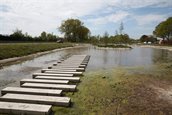Villagers enjoy meeting in climate-proof Feanwâlden Spoarpark
Until 2016, a provincial road between the Frisian towns of Dantumadiel and Tytsjerksteradiel ran straight through six villages. The construction of a new provincial road around these villages opened up opportunities for re-purposing the old road. One of the results: a large, climate-proof park in the village of Feanwâlden, comprising, among other things, a wide pond featuring 5,000 water plants; a bioswale; cycle paths; and footpaths.

What preceded the new park?
The year 2015 saw the construction of provincial road N356 – also referred to as the Central Axis. The road was constructed around the six villages for three reasons: to relieve the villages and to improve liveability, whilst concurrently enhancing the accessibility of Northeast Friesland. At about the same time as the construction of the Central Axis, the Village Opportunities project was launched, aimed at re-designing the old provincial road. Between 2015 and 2022, under this project, the municipalities of Dantumadiel and Tytsjerksteradiel collaborated with the province on this renovation. Through feedback groups, local residents, schools, nature organisations, and entrepreneurs were involved in the designs, the plans, and the preparations.
Why create a climate-proof park in Feanwâlden?
Nowadays, climate adaptation plays a role in many municipal projects. Furthermore, low groundwater levels necessitate maximum rainwater retention in the area. To this end, a large pond was created, with adjacent bioswales. These collect rainwater and drain the water when necessary. Abundant greenery adds to local heat resilience and allows more water to infiltrate the soil. This helps to reduce waterlogging and drought.

Park makes Feanwâlden whole again
The park in Feanwâlden was created at the former location of the provincial ring road. This old road cut the railway station area off from the village. The new park has re-established the connection between the railway station area and the village.
Park ties in with Feanwâlden cultural-historic character
The park design is based on 19th century Frisian landscape architecture. It comprises a cultural-historic feature of the village, part of which is situated on elevated soil, whilst other parts are located on lower-lying and wetter meadow soil. The elevated section borders on the inhabited village and is composed of open spaces planted with trees and shrubs. The lower section is located along the railway tracks. During severe downpours, rainwater flows to this lower-lying section, which features the large pond and the adjacent bioswales.

Park enhances biodiversity
The Frisia Groep landscaping company was tasked with selecting the greenery. The greenery boosts local biodiversity:
- Wherever possible, indigenous plants, shrubbery and trees were selected, that tie in with the environment. The greenery comprises several layers, with varying growth heights. This creates a welcoming habitat for birds, insects, and other wildlife.
- The area has been planted with 650,000 naturalised bulbous plant species. The idea is to allow them to self-seed and propagate, thus creating more greenery.
- Several mixtures of herbs have been sown, that bloom at different times. This makes for a prolonged flowering season, which benefits insects and other wildlife.
- The municipality only cuts the herbal fields once a year, and the mowed herbs are left on the fields for two days. This allows release of the flower seed and helps its distribution.
- In the large pond, 5,000 water plants have been planted.